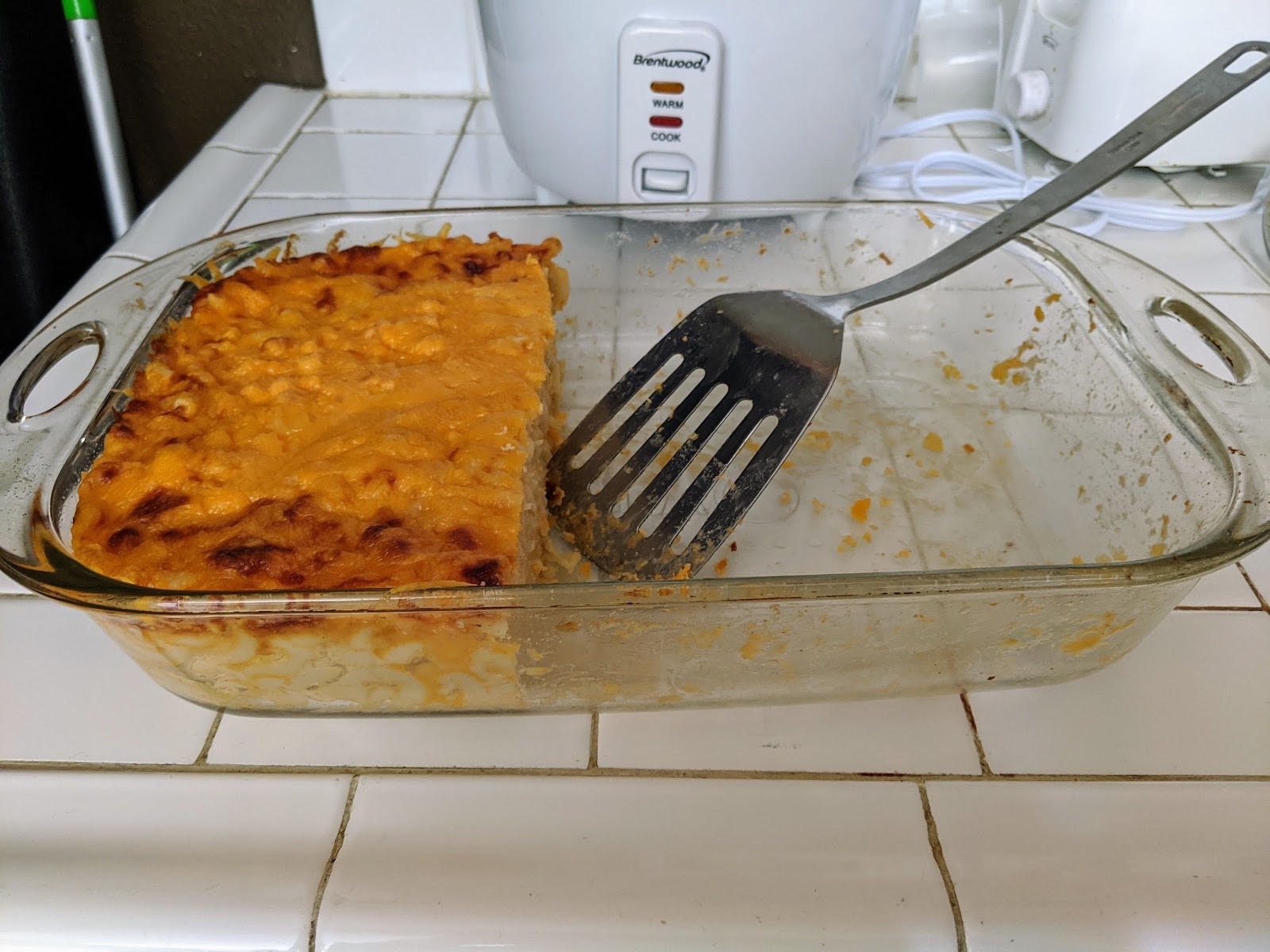Lesson 1
One Piece of One Part
Warm-up: Notice and Wonder: Baked Macaroni and Cheese (10 minutes)
Narrative
Launch
- Groups of 2
- Display the image.
- “What do you notice? What do you wonder?”
- 1 minute: quiet think time
Activity
- “Discuss your thinking with your partner.”
- 1 minute: partner discussion
- Share and record responses.
Student Facing
What do you notice? What do you wonder?

Student Response
For access, consult one of our IM Certified Partners.
Activity Synthesis
- “The picture shows a pan of macaroni and cheese. What other food is baked in pans like this one?” (lasagna, casseroles, cakes)
- “About how much macaroni and cheese is left in the pan?” (It’s less than \(\frac{1}{2}\) and more than \(\frac{1}{3}\). It looks like it is about \(\frac{2}{5}\).)
Activity 1: Of What? (20 minutes)
Narrative
The goal of this activity is for students to draw diagrams that represent a unit fraction multiplied by another unit fraction in context. The macaroni and cheese context was introduced in the warm-up to motivate students to draw a diagram to represent the pan. The focus in this activity is on the different diagrams students draw and how they represent the same situation (MP2). Some students may identify that Lin ate \(\frac{1}{6}\) of the pan. Invite these students to share their observation at the end of the synthesis when they think about the diagrams in relation to the fraction of the whole pan of macaroni and cheese Lin ate.
Advances: Conversing, Reading
Supports accessibility for: Conceptual Processing, Visual-Spatial Processing, Organization
Launch
- “We are going to solve problems about a pan of macaroni and cheese that was served at a big family dinner. Lin is excited that her aunt made her famous baked macaroni and cheese. Tell your partner a story about a dish that you love to eat for dinner.”
- 1–2 minutes: partner discussion
Activity
- 3–5 minutes: individual work time
- As students work, consider asking:
- “How does your diagram show \(\frac{1}{2}\)?”
- “How does your diagram show \(\frac{1}{3}\) of \(\frac{1}{2}\)?”
- “How did you decide how to partition the rectangle?”
- Monitor for students who draw different diagrams to show \(\frac{1}{3}\) of \(\frac{1}{2}\) such as those shown in the student solutions.
Student Facing
- Draw a diagram to represent the situation.
- Explain or show how you know your diagram represents the situation.
Student Response
For access, consult one of our IM Certified Partners.
Advancing Student Thinking
Activity Synthesis
- Ask selected students to display their responses side by side for all to see or use the images provided in the student solutions.
- For each diagram ask: “How does the diagram represent \(\frac{1}{3}\) of \(\frac{1}{2}\) of the pan?” (First, the rectangle or pan is divided in half and then a third of one half is shaded.)
- “How are the diagrams the same?” (They all show the full pan cut in half. Then they show a half cut into 3 equal pieces and one of those pieces is shaded.)
- “How are the diagrams different?” (One diagram cuts the pan in half horizontally and the other two cut it in half vertically. The other cuts into 3 equal pieces are also sometimes horizontal and sometimes vertical.)
- “How much of the whole pan did Lin eat?” (Students may say \(\frac{1}{6}\) or other fractions.)
- Record all responses and revisit this in the lesson synthesis.
Activity 2: The Same, but Different (15 minutes)
Narrative
- cut out and compare the shaded pieces explicitly
- reason that they are each \(\frac{1}{4}\) or \(\frac{1}{2}\) of the same amount
- reason that they are each \(\frac{1}{8}\) of the whole
Launch
- Groups of 2
Activity
- 1–2 minutes: quiet think time
- 5–8 minutes: partner discussion
- Monitor for students who:
- extend the dashed lines in diagram A to determine that \(\frac{1}{8}\) of the whole square is darkly shaded
- partition the rest of the square in diagram B to determine that \(\frac{1}{8}\) of the whole square is darkly shaded
Student Facing
-
Explain or show how each diagram represents \(\frac{1}{4}\) of \(\frac{1}{2}\) of a pan of macaroni and cheese.
A B - Use the diagrams to show that \(\frac{1}{4}\) of \(\frac{1}{2}\) is \(\frac{1}{8}\) of the whole pan.
Student Response
For access, consult one of our IM Certified Partners.
Advancing Student Thinking
Activity Synthesis
- Ask previously selected students to share in the given order.
- “How does each diagram represent \(\frac {1}{4}\) of \(\frac {1}{2}\)?” (They each show \(\frac{1}{2}\) shaded in the lighter blue and then \(\frac{1}{4}\) of that half is shaded darker.)
- “How do we know the darkly shaded pieces are the same size?” (I cut them out to check. They are both \(\frac{1}{4}\) of \(\frac{1}{2}\). They both represent \(\frac{1}{8}\) of the whole pan.)
- If not already mentioned by students, ask: “How can we figure out how much of the whole pan of macaroni cheese the dark shaded piece represents?” (We can extend the lines in diagram A and we can partition the rest of the square in diagram B.)
- “\(\frac {1}{4}\) of \(\frac {1}{2}\) is equal to how much of the whole pan of macaroni and cheese?” (\(\frac{1}{8}\) of the whole pan.)
Lesson Synthesis
Lesson Synthesis
“Today we drew diagrams to represent fractions of fractions. What did you learn about fractions of fractions?” (They are pieces of pieces.)
Consider asking students to respond in their journals.
Refer to the diagrams students drew to show \(\frac{1}{3}\) of \(\frac{1}{2}\) of a pan of macaroni and cheese.
“How much of the whole pan of macaroni and cheese did Lin eat? How do you know?” (\(\frac{1}{6}\). I would need to divide the whole rectangle, not just the one half that was left. Then there would be 6 equal parts and Lin ate one of them.)
Cool-down: Macaroni and Cheese (5 minutes)
Cool-Down
For access, consult one of our IM Certified Partners.

